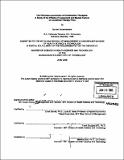The pharmaco-economics of combination therapies : a study of the effects of component and market factors on combined therapy price
Author(s)
Subramaniam, Sundar
DownloadFull printable version (2.360Mb)
Other Contributors
Sloan School of Management.
Advisor
Frank Douglas.
Terms of use
Metadata
Show full item recordAbstract
For a growing number of indications, combination therapies are becoming increasingly common due in part to their superior efficacy, as compared to monotherapies. In fact, in the case of infectious diseases such as AIDS and tuberculosis, combination therapies are now the standard of care. With the emergence of drug-device combinations, genetic testing, and individualized medicine, this trend towards combination therapies is likely to continue to grow. In this context the pricing of combination therapies is a critical component that needs to be understood by medical practitioners, payors and policy makers. There are three factors to consider in the pricing of combination therapies: the characteristics and structure of the market in which the combined product is sold, the absence or presence of market exclusivity, and the prices of the components of the combined product, when sold individually. When one or more of the components of the combined product has market exclusivity, additional factors such as exclusionary bundling, tying, and double marginalization may come into play. (cont.) In this thesis I discuss combination therapies, describe the factors that can affect the pricing of combination therapies, and then attempt to identify the relationships among component pricing, market forces, market exclusivity and the pricing of combination therapies. To illustrate these relationships empirically, I will analyze data from a sample of unified combined drugs, a subset of combination therapies. The results of this analysis are consistent with a hypothesis that, for combination drugs with a patented ingredient, the elimination of double marginalization by efficient transfer pricing and economic and exclusionary bundling, lowers the price of the unified combination drug relative to the price of its constituents.
Description
Thesis (S.M.)--Harvard-MIT Division of Health Sciences and Technology; and, (M.B.A.)--Massachusetts Institute of Technology, Sloan School of Management, 2006. Includes bibliographical references (leaves 47-48).
Date issued
2006Department
Harvard University--MIT Division of Health Sciences and Technology; Sloan School of ManagementPublisher
Massachusetts Institute of Technology
Keywords
Harvard University--MIT Division of Health Sciences and Technology., Sloan School of Management.